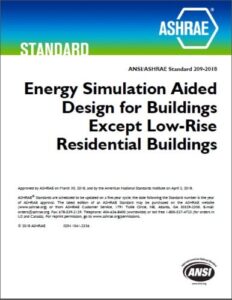ANSI/ASHRAE Standard 209-2018
ANSI/ASHRAE Standard 209-2018
ASHRAE Standard 209 Energy Simulation Aided Design for Buildings Except Low-Rise Residential Buildings describes a methodology to apply building energy modeling to the design process. The Standard Project Committee recognizes the important role building energy modeling plays in informing the design and operation of low-energy buildings. The standard was created to define reliable and consistent procedures that advance the use of timely energy modeling to quantify the impact of design decisions at the point in time at which they are being made. The committee believes such an approach will improve modeling effectiveness, realize greater savings, and support achieving increasingly aggressive energy savings targets.
You can also read Principles of Heating Ventilating and Air Conditioning 8th Edition 2017
ANSI/ASHRAE Standard 209-2018 Content
- Energy Simulation Aided Design for Buildings Except Low-Rise Residential Buildings
- SECTION PAGE
![ASHRAE Standard 209]()
- Foreword
- Purpose
- Scope
- Definitions, Abbreviations, and Acronyms
- Utilization
- General Requirements
- Design Modeling Cycles
- Construction and Operations Modeling
- Postoccupancy Modeling
- Normative References
- A: Climate Information
- B: Benchmark Information
- C: Simple Box Modeling
- D: Owner’s Project Requirements
- E: Quality Assurance and Quality Control Checklists
- F: Informative Reference
The standard defines general modeling requirements coupled with eleven modeling cycles, each with specific modeling goals that align with distinct phases of the design, construction, or operation process. Each modeling cycle is an extension of the general modeling requirements, which represents a best practices approach for using modeling to inform design. Seven of the modeling cycles coincide with the building design phase, three modeling cycles are applied during building construction, and one occurs post occupancy. The post occupancy analysis is included to help both the owner and modeler understand how modeled results compare to actual energy performance to inform operation and assumptions used in future modeling projects.
Define minimum requirements for providing energy design assistance using building energy simulation and analysis.


Comments are closed.